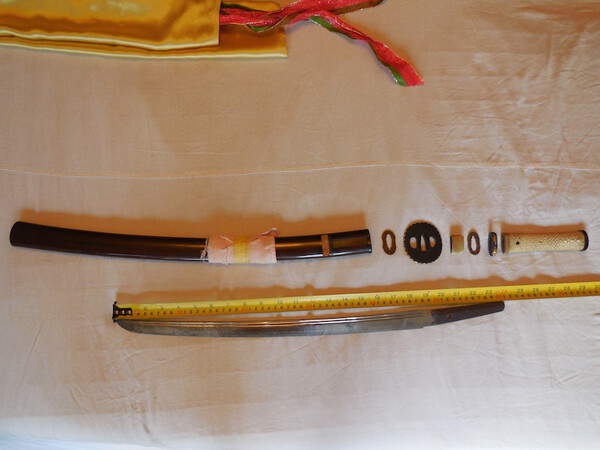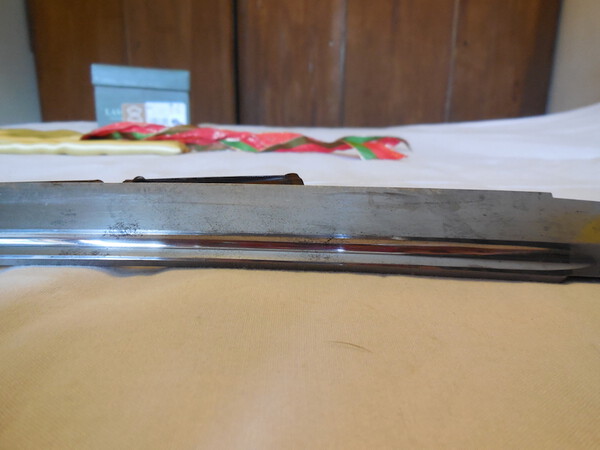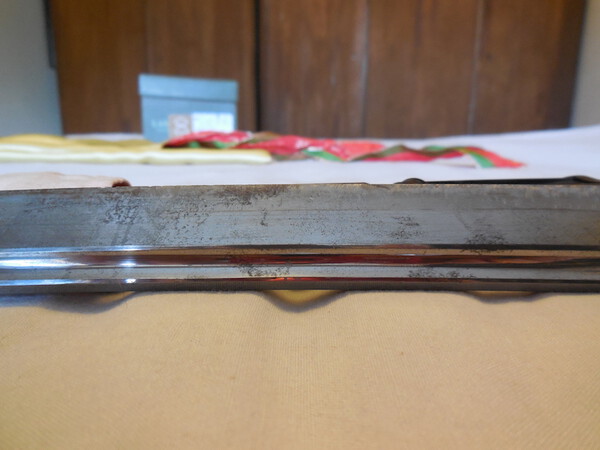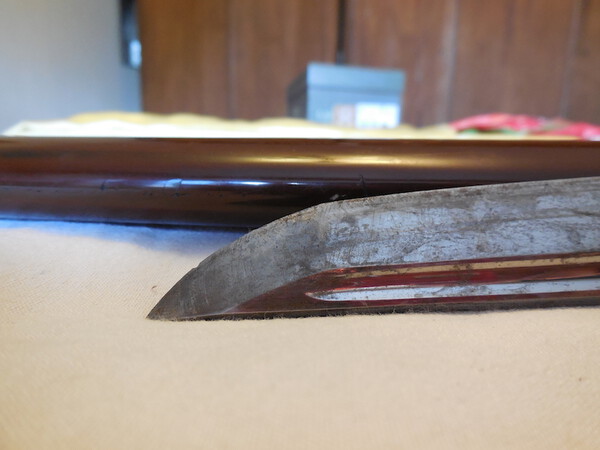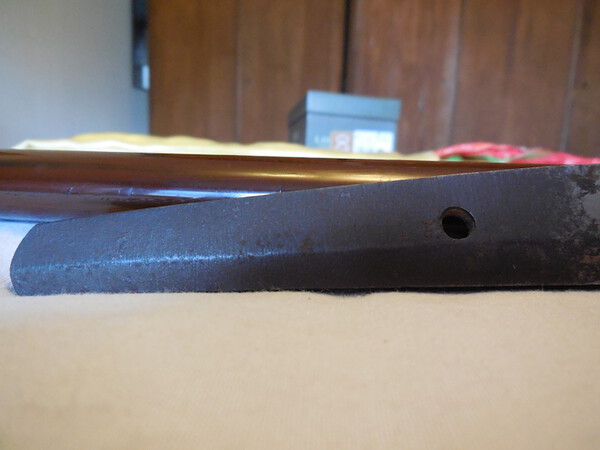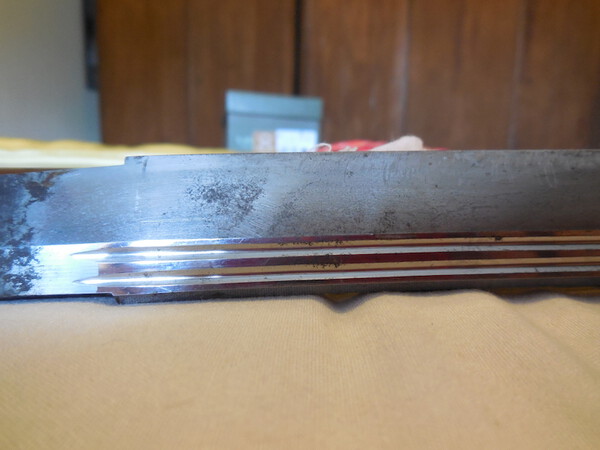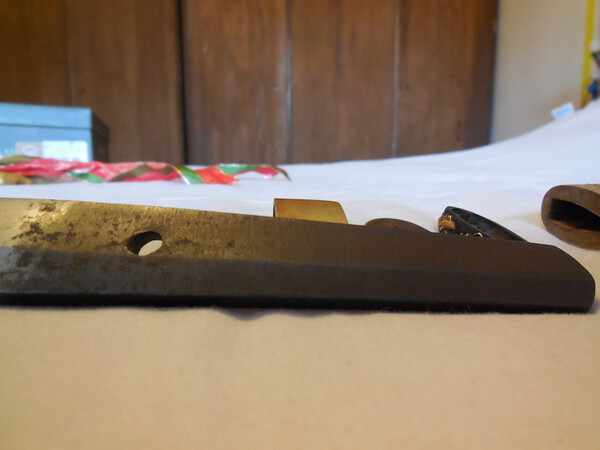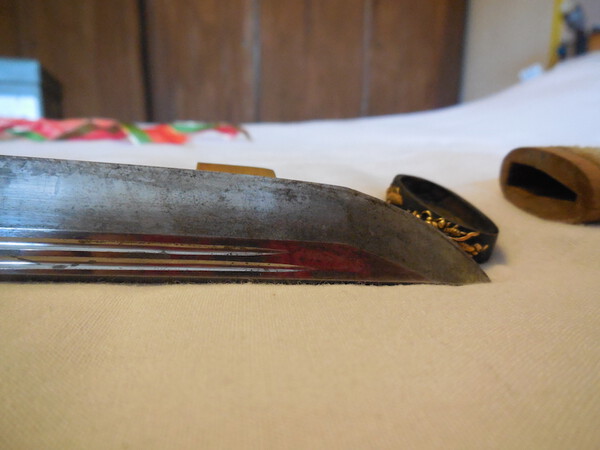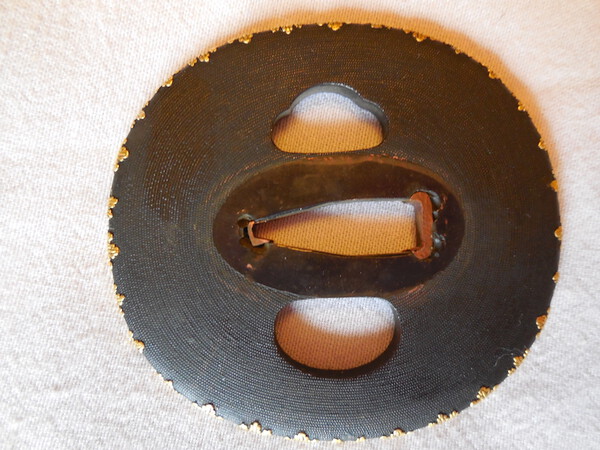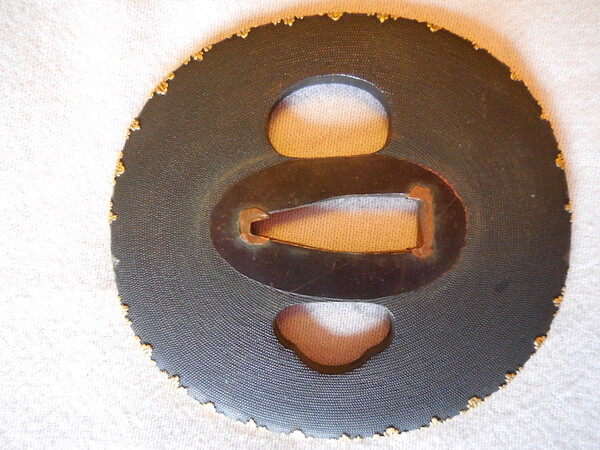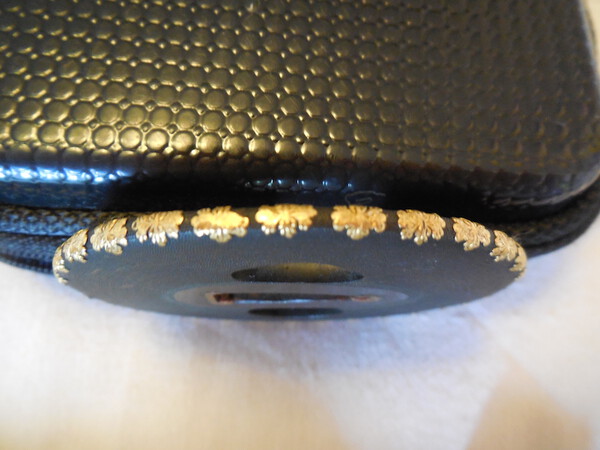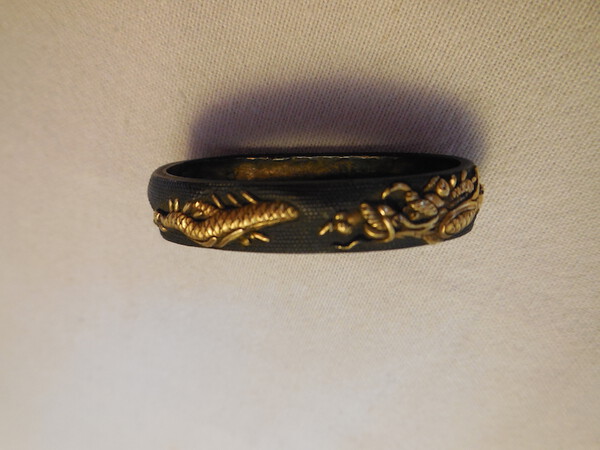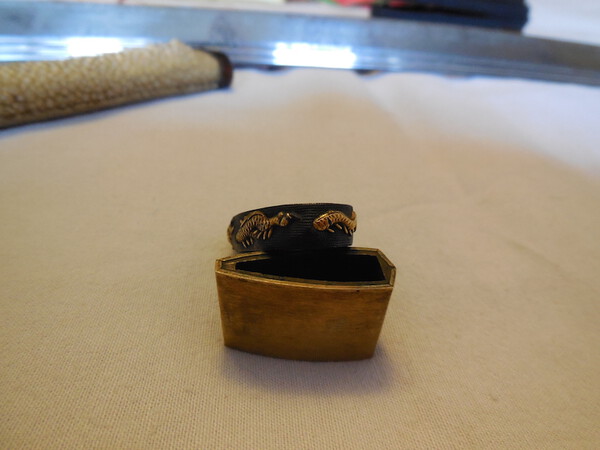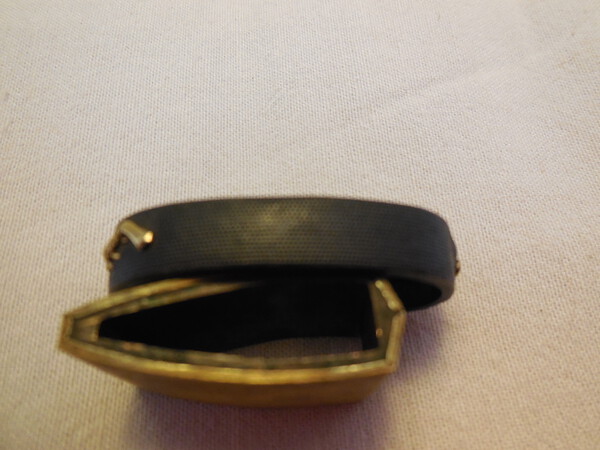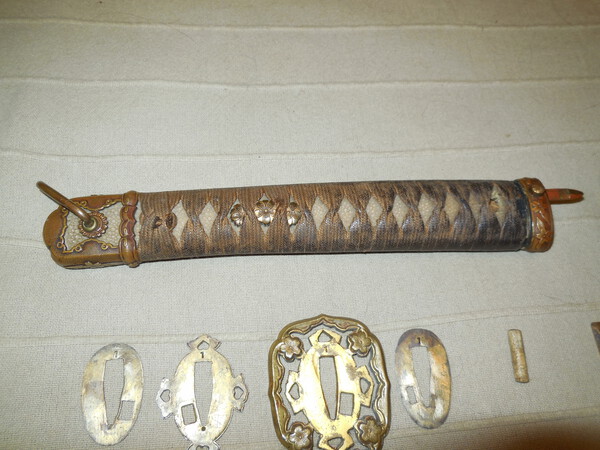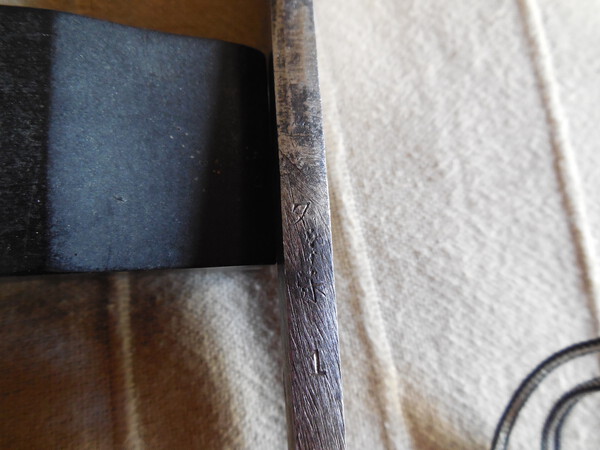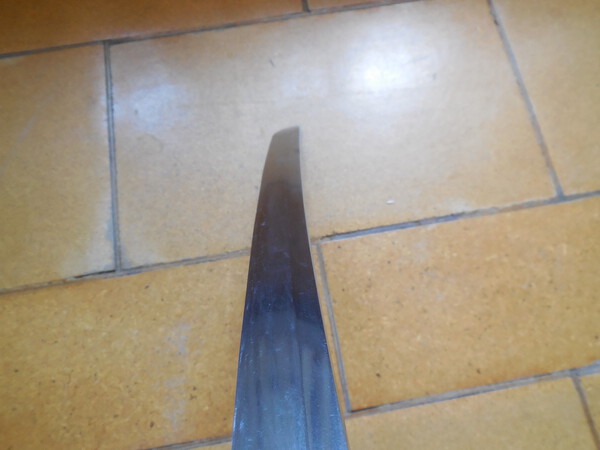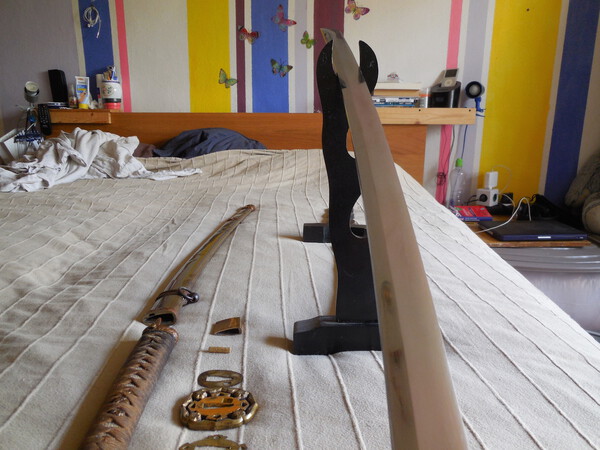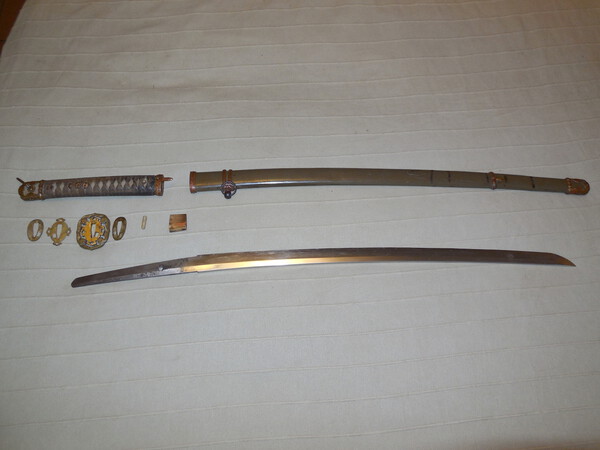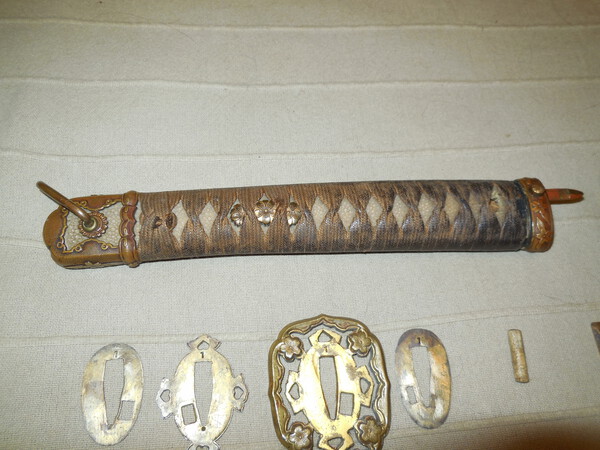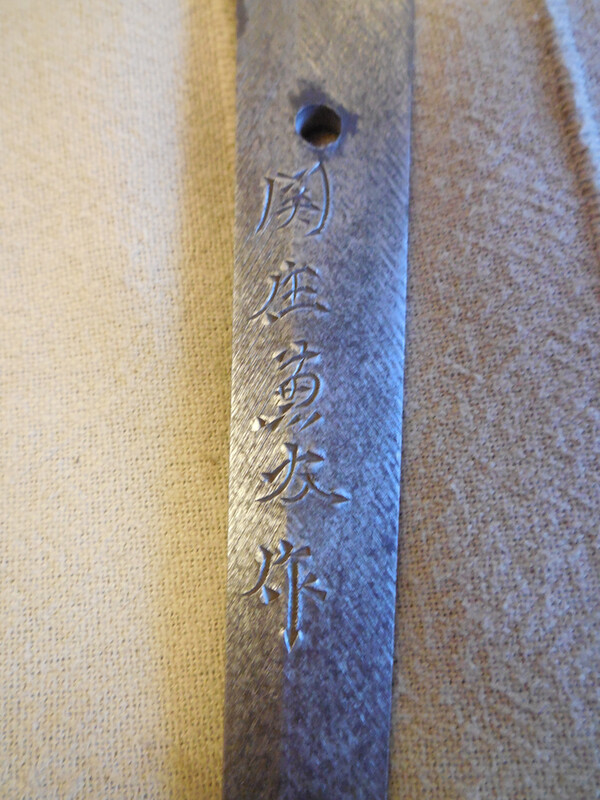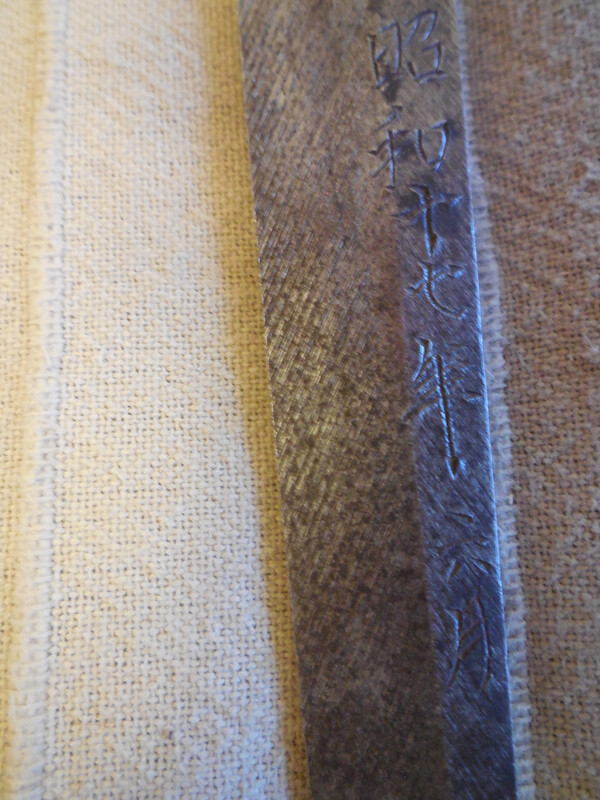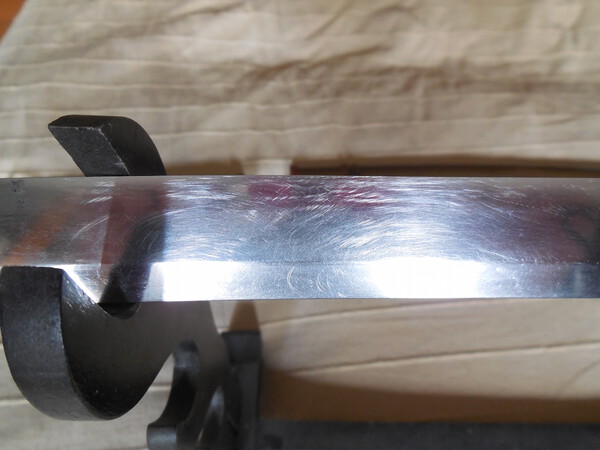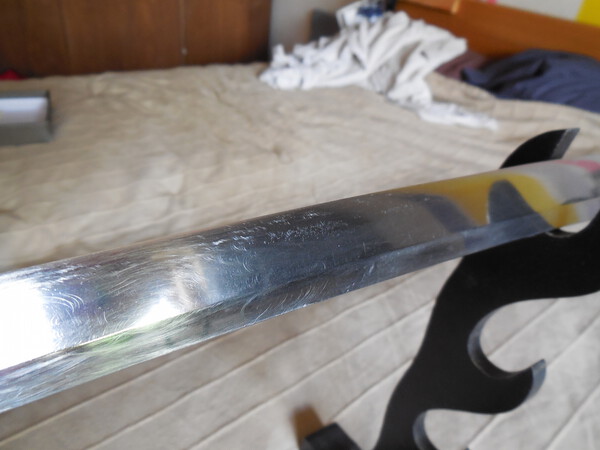-
Posts
45 -
Joined
-
Last visited
Content Type
Profiles
Forums
Events
Store
Downloads
Gallery
Everything posted by Wouter
-
Hi Ron, I'm afraid you are referring to the box of my digital camera... Would have loved it to be nanako. Wouter
-
Thank you, Brian. Coming from you, this means a lot to me. The "forum member" I mentioned (staying anonymous since I don't have his answer yet) wrote this: "Based on the stout, fairly straight profile of the blade, I'd hazard a wild guess that it is from either two time periods, late 1600's or 1800's. Difficult to judge with these pics and not knowing the length. The fittings are good. Especially the tsuba. The fuchi is nice but not in the same league as the tsuba based on the quality of the nanako pattern(raised dots). The tsuba is made from shakudo, an alloy of copper with a small percentage(generally 2 - 7%) of gold. The ground pattern is nanako, which means fish roe, and is normally done with a single punch per raised dot. The gold symbols are called Kiri-mon, Kiri being the paulownia flower and mon meaning family crest. The Kiri-mon was a governmental seal. I would probably class the tsuba as Kyo-kinko (kinko meaning soft metal) which essentially means it's not attributable to a particular school but was made by a soft metal artist sometime in the Edo period, 1600's -1860's. I'd put it at the later end of that scale. It is possibly Goto school but I don't think the quality is there as their work was superb. The fuchi is in shakudo with a gold/gilt dragon. Good quality but not as good as the tsuba." Do you have a contact for Kunitaro San? Wouter
-
Indeed would have been my guess too, but he was very specific on the dates '14-'18. Then again, my Czech is very basic and time tends to colour family stories. Wouter
-
Thank you for your reply. There was indeed a hidden and very general question: what did I purchase? Under normal circumstances, I would agree and not pay too much attention to those fisherman's tales, but we spend over an hour together and he had actual pictures of the soldier holding the sword, his great-grandfather during a zabíjačka, holding the blade with the family around, etc.. I have asked for scans, but they are very simple people... Wouter
-
Hi all, For my second sword (not calling it a nihonto yet), again I have sinned against all the good advice found on this forum. In stead of, being an amateur, buying Papered/Polished/Perfect, I felt compelled to save this sword from a terrible faith. Short version of a very long story: A forum member contacted me for advice on posting a sword from the Czech Republic. It ended up with me going to Prague last Monday and purchasing the wakizashi(?). I will let the pictures speak for themselves. Although before-mentioned forum member has proven very knowledgeable on the tsuba, I would very much like to pick your brains and explore your enormous expertise. I took a gamble assuming that a “nice” tsuba should accompany a quality blade. After applying some uchiko, the very rusty blade looks promising indeed. My Czech is far from perfect, but this is what I understood of the recent history of the sword: It was brought home to Russia by a soldier after the First World War. (this is already an intriguing fact. Not clear on the connection between WW1-Russia-Japan) Shortly after the war, his grandfather moved to newly founded Czechoslovakia and lived in current Slovakia. He used the sword on his farm to kill horses and pigs. Back then, the sword was complete, but over time has lost “the small knives” and was damaged. When his grandfather died, the former soldier passed on the sword as a family heirloom and it ended up in the Czech Republic, in a small village near Prague, where the son continued the tradition to kill pigs with it (googling some pics of ‘zabíjačka’ will give you a good image of the tradition) Wouter
-
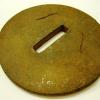
Help With Id, Ww2 Shin-Gunto? Kanetomo 55?
Wouter replied to acedraven's topic in Military Swords of Japan
Hi, The sword "Kanetomo 55" is actually sitting on my desk. So it was a nice surprise to see you make the reference. I purchased it in May this year. I did run to this forum to find out more about the smith and the sword, so if you do a search on my name, you will find those posts and hopefully find some useful information. If you do find out more yourself, please do not hesitate to share. Always happy to learn more. Cheers, Wouter -
Thank you, thomas. You are probably right, even I start doubting, looking at the real thing. But, then again there is definitely something there and I have seen the exact same marking on another sword from the same smith and period. Unfortunately no pictures. Hopefully one day this mystery will be solved... Cheers, Wouter
-

Shipping sword from Czech Republic
Wouter replied to Lee Bray's topic in General Nihonto Related Discussion
Interesting topic. I have been living in the Czech Republic for 4 years now, but never shipped out any swords. The passed days I did some asking around. These are my findings: First of all the main site of the Czech postal office, package department. This is the direct link (in English): https://www.ceskaposta.cz/rady-a-navody/nedovoleny-obsah-zasilek As you can see, weapons or nor listed as prohibited items, nor as restricted items: Prohibited and restricted goods We refuse to carry any of the illegal or harmful items listed below: explosives, radioactive substances, narcotic and psychotropic substances, poisonous and caustic substances, infectious biological substances, solid carbon dioxide, pressure vessels, compressed or liquid gases and gas solutions, biological agents and toxins, oxidising, flammable and other chemical substances and preparations which are classified as dangerous under section 2 of the Act No. 157/1998 Coll., on chemical substances and chemical preparations and on modification of certain other laws, as amended, the Decree No. 474/2002 Coll., which implements the Act No. 281/2002 Coll., on certain measures connected with the prohibition of bacteriological (biological) and toxin weapons and on modification of the Trade Act, living vertebrates. Restricted goods (things we can carry but with restrictions)Any of the following items may be posted providing it meets all our requirements for acceptance of the item: perishable biological substances are mailable providing that should the substance deteriorate, it will neither cause an obnoxious odour, nuisance or disturbance nor leak through the package of the item, living animals other than vertebrates are mailable providing that they will not require a special care and attention during delivery, easy-to-break goods are mailable in special package protecting the goods from harm during standard handling of the item, liquids are mailable provided they are properly packed to prevent any leakage through the package of the item. Coins or banknotes, precious metals or stones, securities, jewels and similar things of value are mailable only if expressly permitted by the conditions of the selected service. I did check with the local office and they confirmed. The only issue they could think of was the import tax that you will have to pay to customs, which can be steep. I have also contacted the main shipping services local dispatches (DHL, UPS, …) and they transport weapons without issues as well. Maybe you could also contact these companies, producing weapons in the Czech Republic and exporting worldwide and see what comment they have. http://www.armaepona.cz/en/ http://www.wulflund.com/en/shipping-worldwide-info.php http://www.myarmoury.com/talk/viewtopic.php?t=29579 (comment on the excellent shipping service from Wulflund) This is the theoretical part: I am afraid it is now in the hands of the seller to take the decision and necessary steps. Hoping this was helpful, Best regards, Wouter -
Hi, Thank you for starting this so needed thread. Last May I bought a Type 98, signed Seki-Ju Kanetomo (confirmed Miwa Kanetomo), dated Showa 17, June. More details and pictures- and questions- are posted here The tang is not star stamped. On the mune there is a Na(goya) and Ho control stamp, and the number "1", matching the seppa and tsuba. There are no other stamps anywhere on the sword. What is intriguing is what seams to be a minuscule star stamp between the Na and Ho. At first I thought it was rust and I was "wishing upon a star", but I have seen a similar stamp (?) on another sword by the same smith at the exact same spot. Unfortunately I was unable to take a picture. I have not been able to find any information and was hoping you could help me? Looking forward to your replies, Best regards, Wouter
-
Thank you for all the useful replies. As promised, some pictures. Still experimenting with size, I do hope this resolution is OK. The picture of the mune stamps I will also post in the "arsenal stamps" thread. Best regards, Wouter
-
thank you, SwordGuyJoe, To the point and very valid. Indeed mounted to be worn edge down and signed tachi-mei. In the first post, first link there are some pictures, but they are not mine. Currenlty I am on a business trip, so can't upload any. I will try later. Wouter
-
Hi Lee, the sword was sent to me from slovakia without any issues. As advised on the forum by so many I bought 'the' books and started studying. I had ordered the books via Amazon US and it was quite a struggle dealing with the customs to get them here. At the end I had to pay taxes and administrative costs. The total price was higher than what I actually paid for the books. So I can only imagine how difficult it must be to post a 'weapon'. If I learn more, I will difinitely post an update. In theory we are part of the European Union, but I guess we still have a long way to travel... Wouter PS I am not planning on selling the sword. To me its historical value -apart from being nihonto or not- is priceless. Every sword has it's story and being my first buy is only a very small part of it.
-
Sorry for the confusion, as I pointed out, after the gendaito (link 2) had been sold, it dissapeared from their site and is now linked to that dagger. Unfortunately I'm not able to edit that post now to remove the link. Wouter
-
Thank you for pointing that out. Pls also see the reply from SwordGuyjoe. Wouter
-
***Update*** I have not found lots of information so far on this tachi, hence still not calling it a gendaito. On the mune, between the Na and the Ho stamp, there appears to be a miniscule 5 pointed star. Now, I could be wishing upon a star, but the exact same 'stamp' was also visible on the gendaito offered via the 2nd link in my first entry of this post. Unfortunately, that link is no longer pointing to the gendaito attributed to Ryuminsai. I couldn't find it either under 'sold items' on their site. Makes me wonder if anyone else has seen this on other gendaito? Although I have been -very carefully- uchiko'ing the blade, some activity and the rest of the hamon is starting to appear, but yet too many scratches to really tell what I have. I am considering a window polish, but living in the Czech Republic, I do not know if any good polishers live nearby. For completeness:I did reach out to the seller (2nd link) with the information I had gathered here. He did thank me for the information, but sold the gendaito as work from Ryuminsai anyway. Well, apparantly it is -was- not that unusual that swords are attributed to better known masters... Looking forward to your reactions, Wouter
-
Hi all, My name is Wouter and i currently live and work from the Czech Republic. I have studied Japanology in Belgium and always dreamed of possessing a "katana". This is actually my second post, so I have been quite impolite not to introduce myself here. As an excuse I could state that my first buy might a) not be a Nihonto; b) be a candidate for the recently started topic 'worst buy'. If you could find some spare time, maybe you might take a peek at my first post in the 'Military Swords of Japan' discussion thread? (link here) I did receive some very valid information, but still have lots of open questions. Like, this exact gendaito has been described on quanonline.com (link in post), so must have been around a while? I do wonder if anyone on this forum has come accross it? yes, I should have followed your extremely valid advice and have studied, studied, studied and posted here sooner, before buying. But, being a romantic, I do appreciate the historic meaning of my first buy. Besides that, I would like to thank all of you. I have learned so much in so little time, for which i am eternally grateful. And I have bought the recommended (starter) books. Looking forward to your replies and reading through all the unread and yet unwritten posts. Wouter
-
Hi George, thank you for the compliment, swift reply and information. I did find Miwa Kanetomo, an average smith (chu saku), but he did make gendaito as well as showato. Apparently his mei was Noshū Seki Jū Miwa Kanetomo Saku (濃州関住三輪兼友作) Not the "Seki Ju Kanetomo Saku" I'm looking for, but of course many of the RJT used multiple signatures. Then again, he belonged to the sword factory (Limited company, Seki Kyoshin Sha, 有限会社 関共進社), Other members were Kato Kaneharu, ojima Kanemichi, Kojima Kanenori, Takeyama Yoshinao, Fujii Kanefuji, Kurimoto Kanemasa, Tsukahara Kanetsugu, Matsumoto Yoshinori and they signed with "Seki Ju (name) Saku", so is it Miwa Kanetomo after all? And the plot thickens... Wouter
-
Hi all, My name is Wouter and i currently live and work form the Czech Republic. I have studied Japanology and always dreamed of possessing a "katana". Last week I risked my first buy and discovered your forum. Before bothering you with my questions, I would like to thank every contributor to this forum. The information I have found so far has been extremely useful and only augmented my fascination. Please do forgive my lack of knowledge and making this new topic so long. These are my questions: 1. I discovered that the exact same gunto I currently possess has been described here. Please do refer to that site for the pictures of blade, tang and fittings. Yes, the year is incorrect, since Showa 17 is 1942, not 43 as written on that site. They are however correct when saying that the previous owner has "destroyed" the polish and making it impossible to "read" the blade (IE determine if it is gendaito). The Hamon is dead and only visible in 2 spots. I have discovered that there are 3 stamps on the Mune. A Mei, or Nagoya arsenal inspection stamp and a Ho inspection stamp. these are followed by a stamped number 1. This number matches with the tsuba and spacers. There is however no star stamp on the tang, but there are nowhere any arsenal stamps (apart from the inspection stamps). Since the date on this gunto is Sho 17, being the year when the star stamp system got implemented, does this mean that it is not a gendaito? Now I have found this "Gendaito", which is almost exactly the same, including the arsenal inspection stamps on the mune. They describe it as hand forged. This brings me to question 2: The gunto is signed "Seki-Ju Kanetomo". The seller from whom i bought the gunto assigned the signature to Ryūminsai Kanetomo (born as Kiribuchi Mataishi). I found out both are listed as members of the Rikugun Jumei Tosho, but Ryuminsai (KAN2550) is from Gunma, while Seki refers to the city in Mino province, Gifu prefecture. There is about 300 km between both prefectures? Also the Mei (signature) of Ryūminsai Kanetomo is: 上野住人龍眠齋兼友作 “Kozuke Junin Ryūminsai Kanetomo Saku”. Would he also sign as “Seki-ju Kanetomo Saku”? To add to the confusion, the "gendaito" offered via the second link I provided translates the Mei as KANETOMO Kiribuchi (rated one million yen smith in slough's book, pg.69, medium to high grade gendaito, 1st seat 1941 sword exhibition) Are these 3 different persons, or one and the same? Sorry for having made this first entry so long. I do hope you will be able to shed some light on these questions. they have kept me awake for over a week now... Thank you very much in advance, Wouter PS If you are interested in the purchasing history of this gunto. I have reached out to my seller and he confirms it is the same gunto as on quanoline.com. He has bought it from a Czech-American selIer 4 years ago, and he had it from militaryitems.com.


